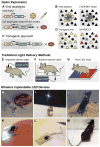Spotlight on pain: optogenetic approaches for interrogating somatosensory circuits
- PMID: 27340912
- PMCID: PMC5069102
- DOI: 10.1097/j.pain.0000000000000620
Spotlight on pain: optogenetic approaches for interrogating somatosensory circuits
Conflict of interest statement
RWG is a co-founder and stockholder of Neurolux Systems. The other authors do not have a conflict of interest.
Figures


Similar articles
-
Optogenetic approaches for investigating neural pathways implicated in schizophrenia and related disorders.Hum Mol Genet. 2014 Sep 15;23(R1):R64-8. doi: 10.1093/hmg/ddu225. Epub 2014 May 13. Hum Mol Genet. 2014. PMID: 24824218 Review.
-
Illuminating neural circuits and behaviour in Caenorhabditis elegans with optogenetics.Philos Trans R Soc Lond B Biol Sci. 2015 Sep 19;370(1677):20140212. doi: 10.1098/rstb.2014.0212. Philos Trans R Soc Lond B Biol Sci. 2015. PMID: 26240427 Free PMC article. Review.
-
Optogenetic inhibition of behavior with anion channelrhodopsins.Nat Methods. 2017 Mar;14(3):271-274. doi: 10.1038/nmeth.4148. Epub 2017 Jan 23. Nat Methods. 2017. PMID: 28114289
-
An excitatory lateral hypothalamic circuit orchestrating pain behaviors in mice.Elife. 2021 May 27;10:e66446. doi: 10.7554/eLife.66446. Elife. 2021. PMID: 34042586 Free PMC article.
-
Functional and Optogenetic Approaches to Discovering Stable Subtype-Specific Circuit Mechanisms in Depression.Biol Psychiatry Cogn Neurosci Neuroimaging. 2019 Jun;4(6):554-566. doi: 10.1016/j.bpsc.2019.04.013. Epub 2019 May 10. Biol Psychiatry Cogn Neurosci Neuroimaging. 2019. PMID: 31176387 Free PMC article.
Cited by
-
In Vivo Interrogation of Spinal Mechanosensory Circuits.Cell Rep. 2016 Nov 1;17(6):1699-1710. doi: 10.1016/j.celrep.2016.10.010. Cell Rep. 2016. PMID: 27806306 Free PMC article.
-
Closed-loop functional optogenetic stimulation.Nat Commun. 2018 Dec 13;9(1):5303. doi: 10.1038/s41467-018-07721-w. Nat Commun. 2018. PMID: 30546051 Free PMC article.
-
Thalamic Bursts and the Epic Pain Model.Front Comput Neurosci. 2017 Jan 12;10:147. doi: 10.3389/fncom.2016.00147. eCollection 2016. Front Comput Neurosci. 2017. PMID: 28127285 Free PMC article. No abstract available.
-
Reticular Formation and Pain: The Past and the Future.Front Neuroanat. 2017 Jul 5;11:51. doi: 10.3389/fnana.2017.00051. eCollection 2017. Front Neuroanat. 2017. PMID: 28725185 Free PMC article. Review.
-
Optogenetic recruitment of spinal reflex pathways from large-diameter primary afferents in non-transgenic rats transduced with AAV9/Channelrhodopsin 2.J Physiol. 2019 Oct;597(19):5025-5040. doi: 10.1113/JP278292. Epub 2019 Aug 28. J Physiol. 2019. PMID: 31397900 Free PMC article.
References
-
- Adamantidis AR, Zhang F, de Lecea L, Deisseroth K. Establishing a fiber-optic-based optical neural interface. Cold Spring Harb Protoc. 2014;2014:839–44. - PubMed
-
- Airan RD, Thompson KR, Fenno LE, Bernstein H, Deisseroth K. Temporally precise in vivo control of intracellular signalling. Nature. 2009;458:1025–1029. - PubMed
-
- Al-Hasani R, McCall JG, Shin G, Gomez AM, Schmitz GP, Bernardi JM, Pyo C-O, Park S, II, Marcinkiewcz CM, Crowley NA, Krashes MJ, Lowell BB, Kash TL, Rogers JA, Bruchas MR. Distinct subpopulations of nucleus accumbens dynorphin neurons drive aversion and reward. Neuron. 2015;87:1063–77. - PMC - PubMed
-
- Aravanis AM, Wang L-P, Zhang F, Meltzer La, Mogri MZ, Schneider MB, Deisseroth K. An optical neural interface: in vivo control of rodent motor cortex with integrated fiberoptic and optogenetic technology. J Neural Eng. 2007;4:S143–S156. - PubMed
Publication types
MeSH terms
Grants and funding
LinkOut - more resources
Full Text Sources
Other Literature Sources
Medical

